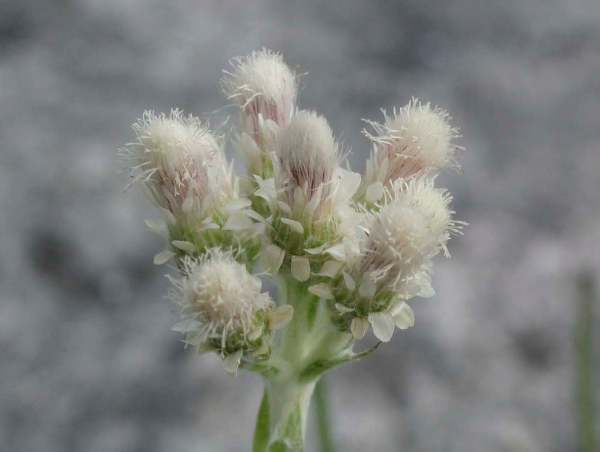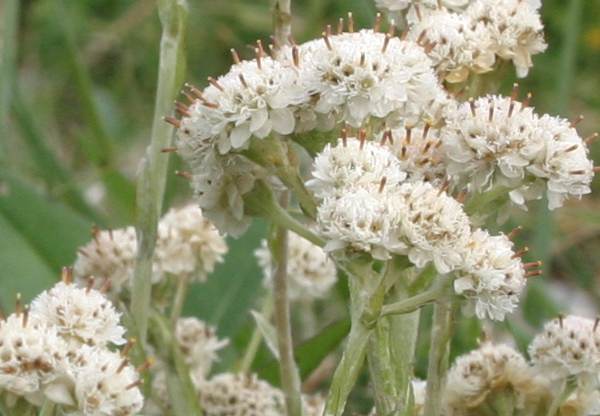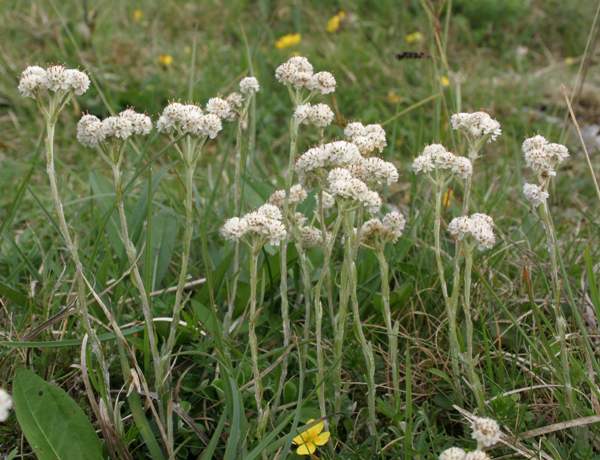Trees Birds Mammals Fish Amphibians Reptiles
Wild Algarve
Bookshop
Antennaria dioica - Mountain Everlasting
Phylum: Magnoliophyta - Class: Equisetopsida - Order: Asterales - Family: Asteraceae

Above: Female flowers of Mountain Everlasting
Most often found in mountainous parts of Europe, this perennial herb grows quite close to sea level on the limestone pavement of Ireland's famous Burren. Antennaria dioica is also known by the alternative common names Cat's-foot and Catsfoot.

Above: Male flowers of Mountain Everlasting
Description
Typically 10 to 20cm in height, Mountain Everlasting has a basal rosette of spoon-shaped leaves typically 4cm long and 1cm across. There are smaller narrowly-lanceolate clasping leaves in a spiral up the hairy flower stems that bear clusters of 2 to 8 flowerheads. This is a dioecious wildflower, producing male and female flowers on separate plants. Flowerheads, 6 to 12mm across, have whitish or pink ray florets surrounding densely packed disc florets. (The female plants have more pink colouring in their flowers.) Reproduction is both by seeds and via stolons, and so some groups of plants may be all-male or all-female clones of a parent plant while other groups, produced by seed, are likely to contain both male and female flowers.
Distribution
Found in mountainous parts of the Mediterranean region of Europe, Antennaria dioica is more common further north. In Britain this is a mountain plant in the south but can be found right down to sea level in northern Scotland. In Ireland this plant grows on the Burren, near sea level. Mountain Everlasting is also found in Alaska, North America, where it is sometimes referred to as Stoloniferous Pussytoes.

Habitat
Mountain Everlasting thrives in dry grassland habitats on base-rich or calcareous soils..
Flowering Times
In Britain and Ireland this member of the Daisy family, Asteraceae (formerly more often referred to as the Compositae), blooms from May through to July. The plants shown on this page were photographed on the Burren in County Clare, Ireland.
Etymology
Antennaria, the genus name, comes from the Latin noun antenna, a reference to the male flowers, which resemble the antennae of insects. The specific epithet dioica means 'with two houses' and refers to the fact that male and female flowers are borne on separate plants.
Sue Parker's latest ebook is a revised and enlarged second edition of the acclaimed Wildflowers in the Algarve - an introductory guide. Full details here...
Buy it for just £3.95 on Amazon...
Sue Parker's 5-star acclaimed field guide to the Wild Orchids of the Algarve is now available as an ebook. Full details here...
Buy it for just £5.95 on Amazon...
Please Help Us: If you have found this information interesting and useful, please consider helping to keep First Nature online by making a small donation towards the web hosting and internet costs.
Any donations over and above the essential running costs will help support the conservation work of Plantlife, the Rivers Trust and charitable botanic gardens - as do author royalties and publisher proceeds from books by Pat and Sue.